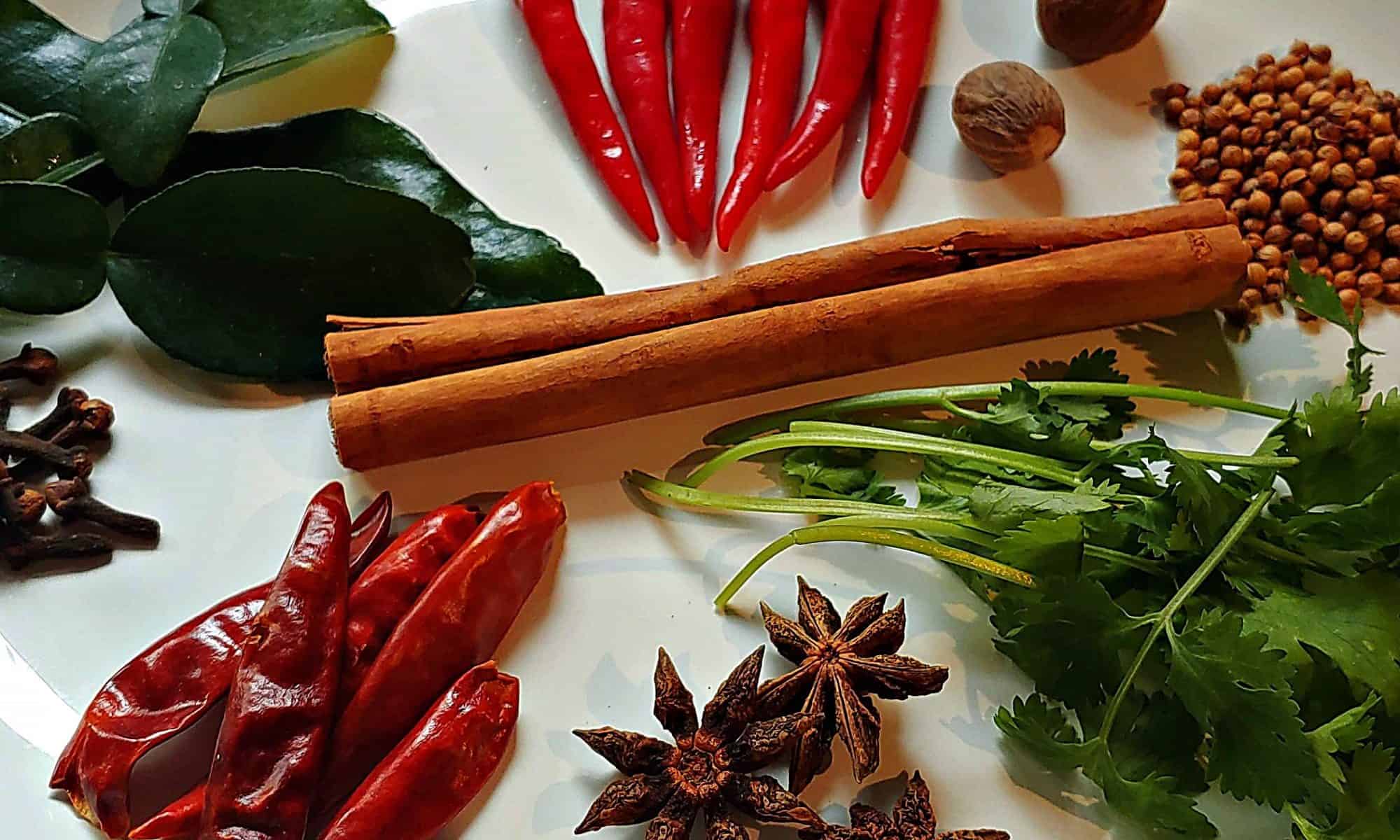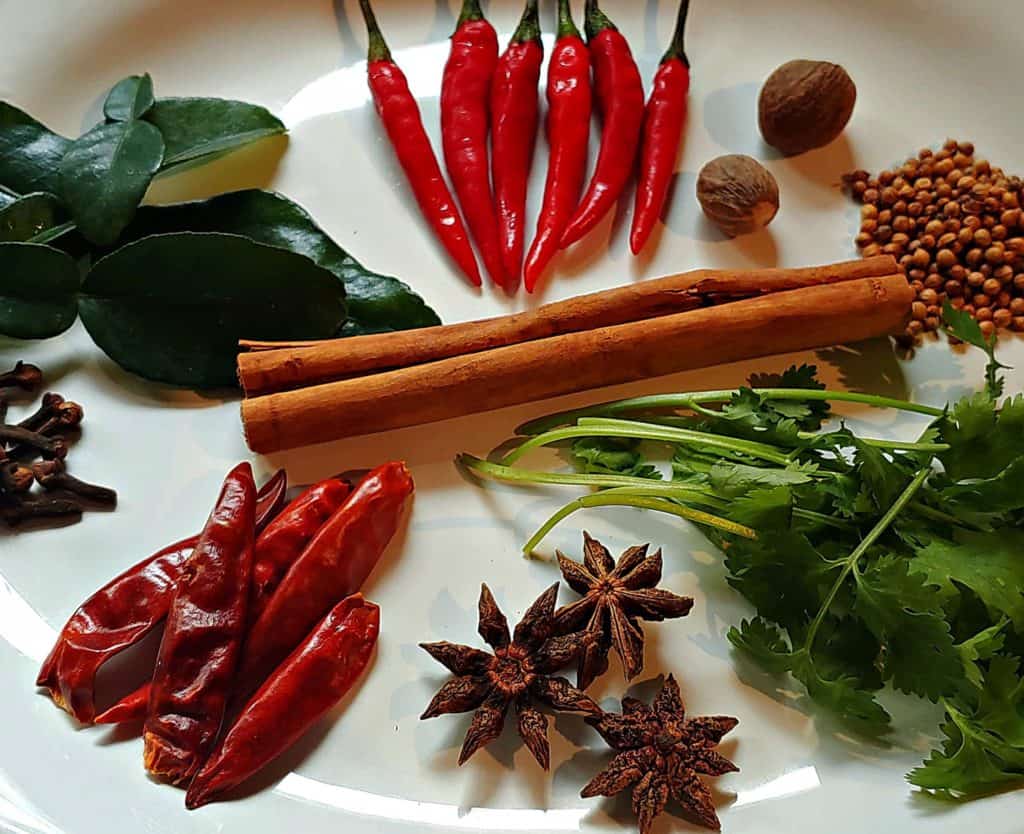
Have you ever wondered what gives Thai food the distinct flavor, aroma, and such vibrant colors? Most of it is the fresh ingredients that many Thais grow at home. Traditional Thai households normally grow their own vegetables and herbs, or they buy them from a local fresh market for their cooking and essential medical benefits.
Here is a list of the most essential vegetables, herbs, and spices that Thai people use in their recipes. And, they will likely have some or all of them in their own backyards.
Now, I know there are a couple fruits and vegetables in this list, but let me tell you, they are essential. So, lets read on so you can understand why I include them.
Roots
1. Finger-root (Krachai)
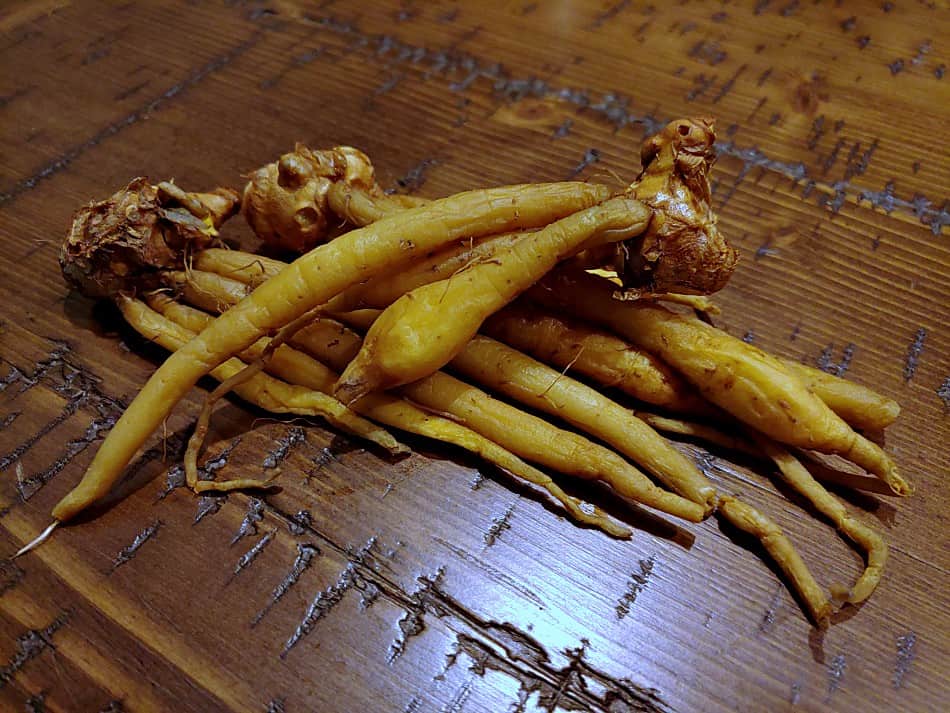
The finger-root is a kind of ginger widely used in Chinese medicine and Thai cuisine. Thai people use it both shredded and whole; shredded to release more juice and stronger flavor. Its strong gingery fragrance cancels out the fishy smell, that’s why it’s used in fish dishes and curries like Kanom Jeen Namya (rice noodles with fish curry sauce), Pad Cha (seafood sizzling stir-fry), and Gaeng Som (Southern Thai sour fish soup). The finger-root is also known as a medical wonder; it helps alleviate dizziness and mouth inflammations.
2. Ginger (Khing)
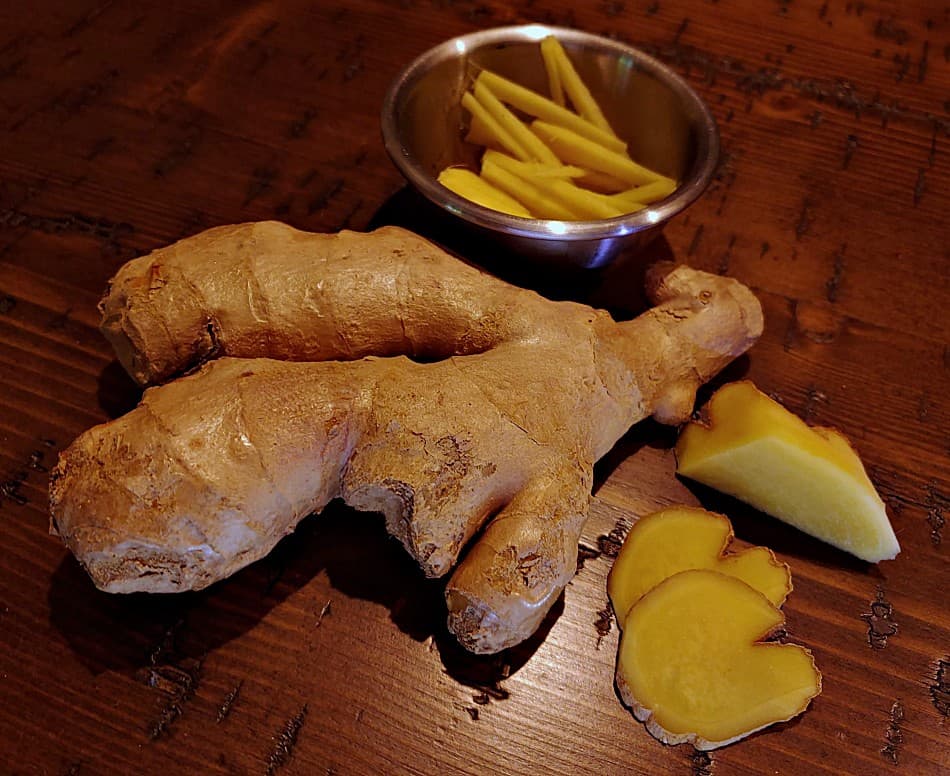
There are two forms of Ginger used in Thailand; young and mature. The young Ginger has a more subtle flavor and is normally sliced with the skin left on and sprinkled over steamed fish. The mature Ginger is spicier which is good for such stir-fries as Gai Pad Khing (ginger chicken stir-fry). Thai people also pound and boil mature Ginger to make home-brewed hot ginger tea with rice pudding which has tons of health benefits.
3. Galangal (Kha)
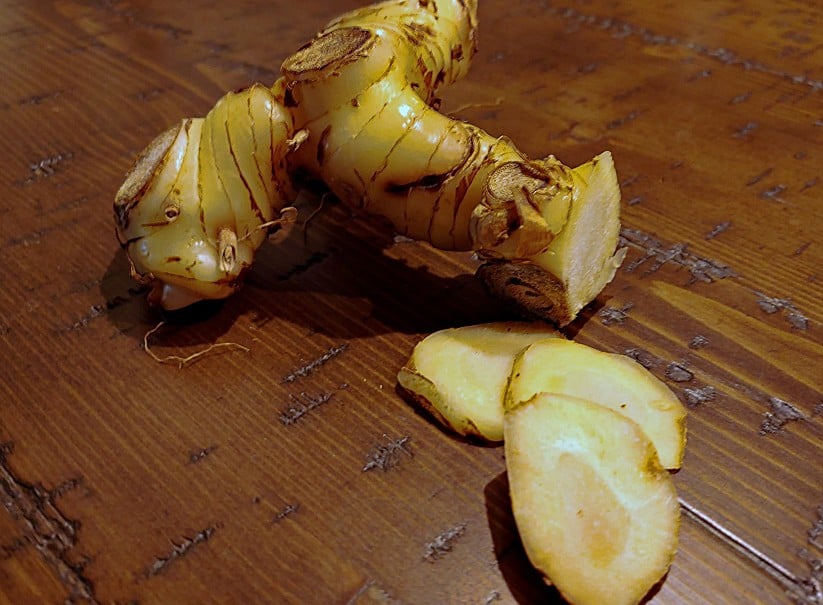
Looking very similar to ginger, Galangal is a pale yellow-pinkish rhizome with a delicate citrus flavor. It is used in many Thai soups such as Tom Yum and Tom Kha – that’s where the “Kha” comes from. Galangal also gives out a zingy, spicy fragrance that is very unique to Thai soups. To prepare it for soup, peel off the skin and slice it to be boiled in a broth with other spices, but remove it before eating since the root is fibrous and hard to chew. Fresh Galangal can be difficult to find, dried Galangal is an acceptable substitute and it can be stored longer.
4. Turmeric (Khamin)
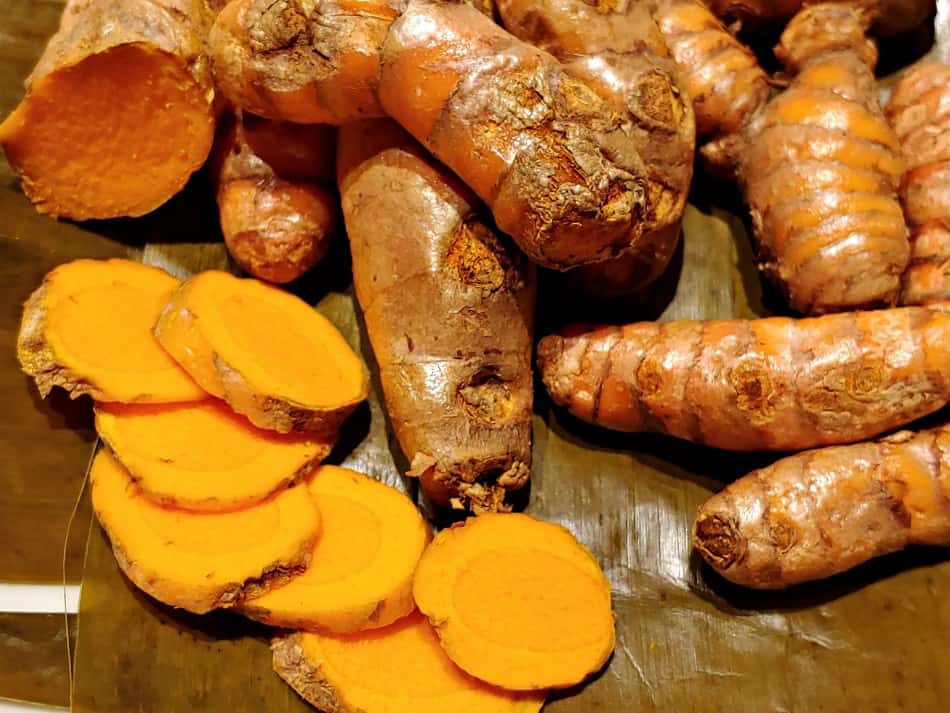
A perennial plant of the ginger family, Turmeric is a yellow-colored rhizome used for flavoring and mostly coloring. This bright yellow root when dried is ground into a yellow-colored powder used as a spice in curries. Yellow Curry, Massaman Curry, Khao Mok Gai (Thai chicken Biryani), and almost any Thai dishes that look yellow get the color from the Turmeric. Dried Turmeric is also traditionally used as a facial cleanser – a secret to the Thai youthful glow!
Onion Family
5. Garlic (Kratiam)
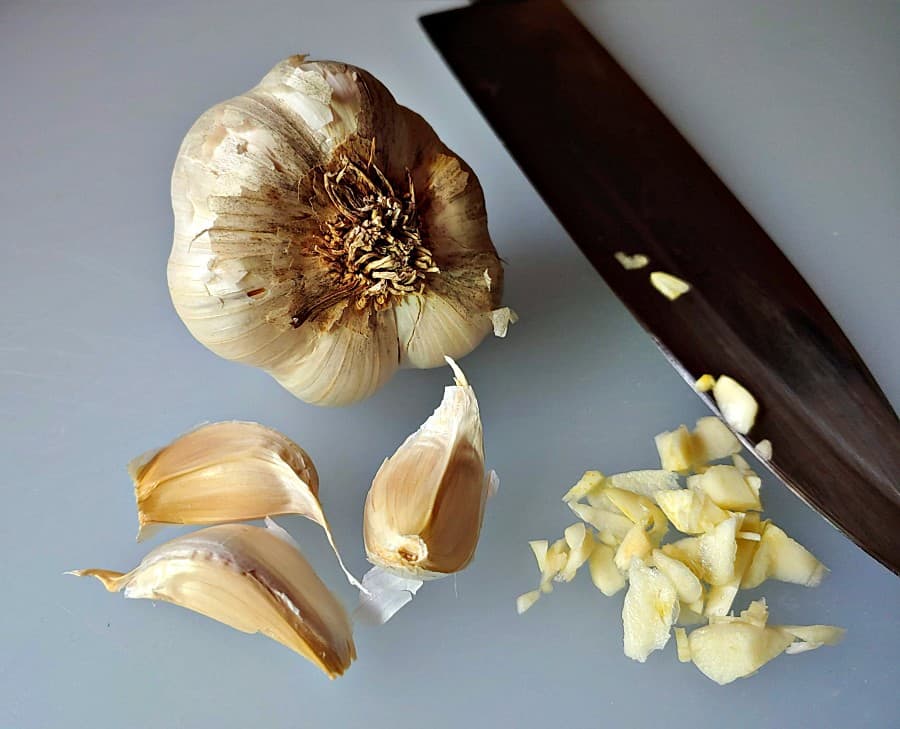
Crushed or chopped, raw or cooked, garlic is the most common ingredient in Thai cuisine. One thing to keep in mind is Thai garlic cloves are much smaller than the Western variety. Always use half of what your recipe from a Thai cookbook/website calls for if you use garlic from a US store. Because the Thai garlic cloves are tiny, most Thai people don’t bother to peel them. The skin can be cooked as well for extra crispiness.
6. Shallot (Horm Daeng)
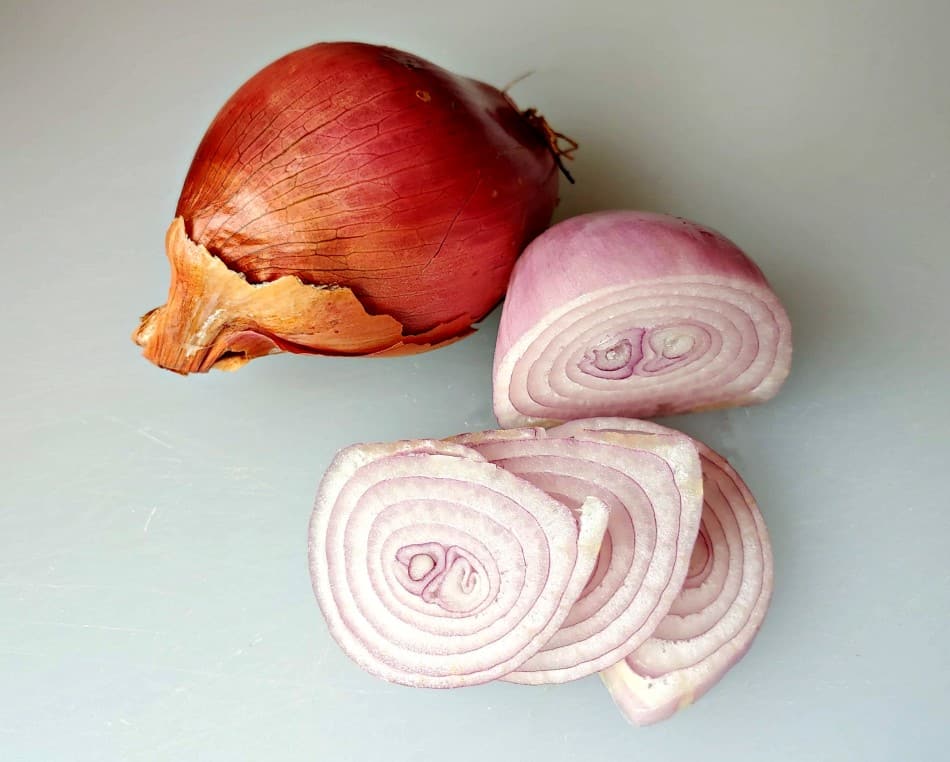
Shallots are small red onions in a bulb form used as a key ingredient in curry pastes. Shallots are made with very fine layers which are better blended into Thai sauces like Nam Jim Jaew (spicy BBQ dipping sauce) for Thai grilled and deep-fried dishes. It is also common to slice the Shallots and fry them into brown, crispy pieces for spicy salad, fried chicken, or even some Thai dessert!
Tip: Despite the size difference, shallots and red onions are quite similar in taste and smell. They can be substituted with European shallots, small red onions, or small brown onions.
7. Spring Onion (Ton Horm)
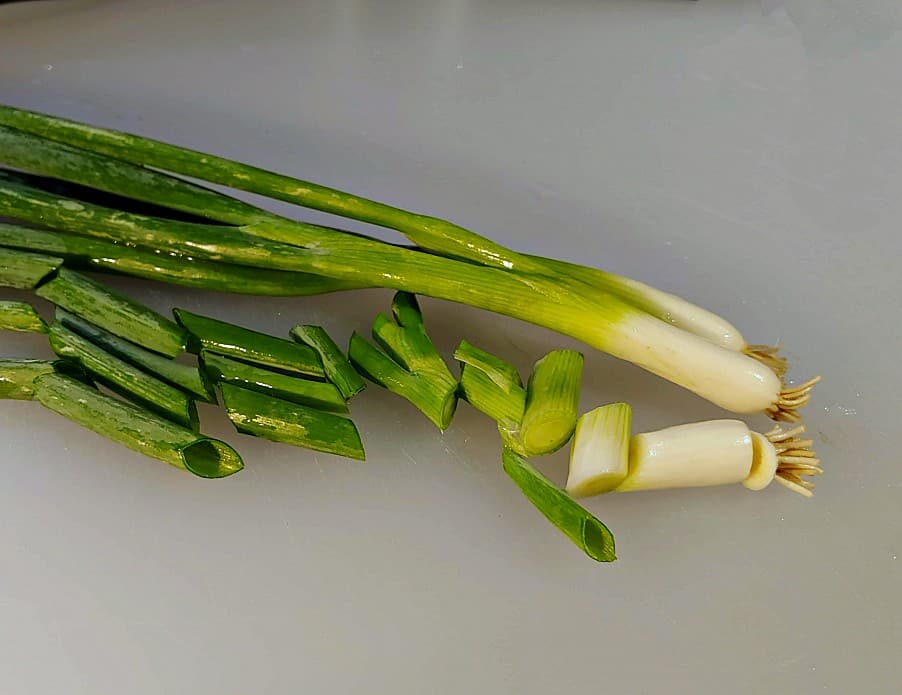
Spring Onions, also called green onions, are mild, long-stemmed, slim onions. Both the white and green parts of these onions, are used mostly for garnishing soups, salads, and stir-fries. They are also eaten fresh as vegetables alongside Pad Thai and fried rice.
Basil’s
8. Holy Basil (Krapao)
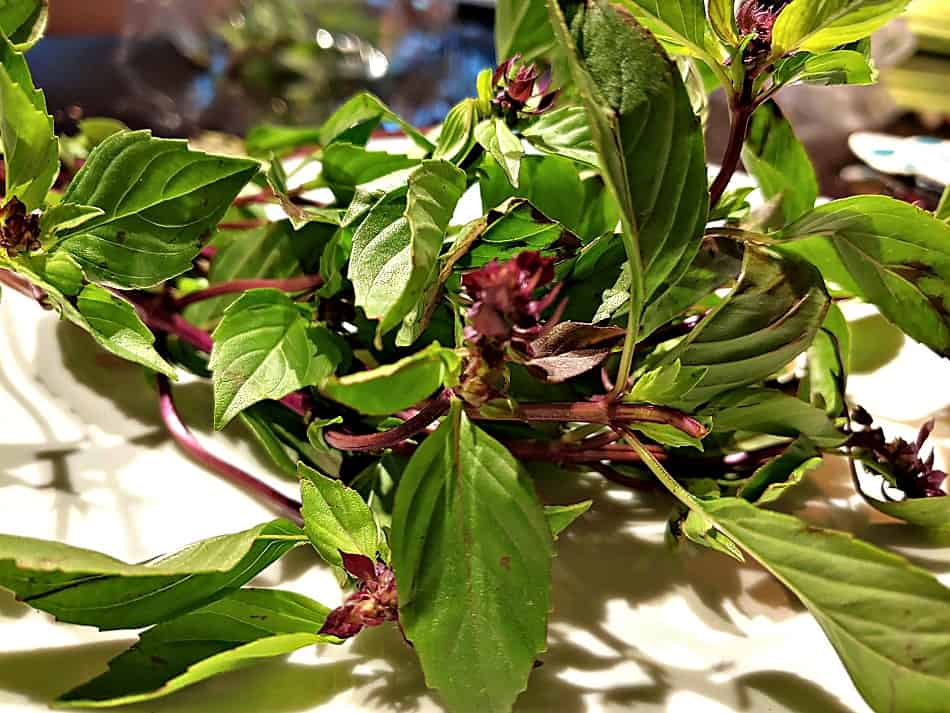
This is the hot, peppery, clove-like form of basil that is used in simple stir-fries together with bird’s eye chilies, garlic, and fish sauce like the all-time famous dish Pad Kra Pao (stir-fried holy basil with ground pork). Holy Basil should not be confused with Sweet Basil. To tell the difference, Holy Basil leaves are pointed with pronounced jagged edges. The Holy Basil will also leave more burning sensation on your palate.
9. Sweet Basil (Horapa)
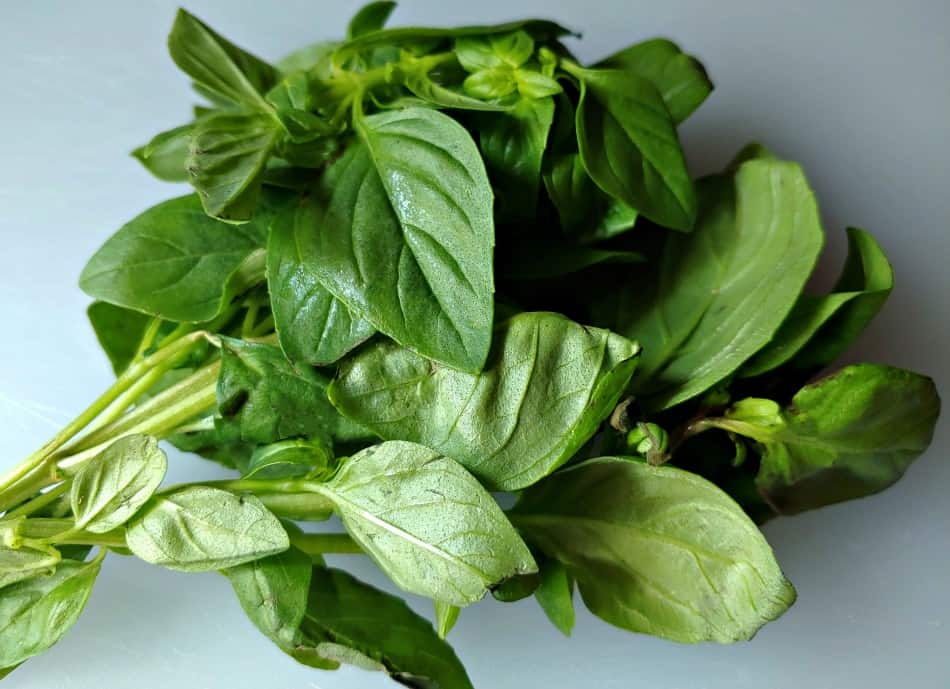
Unlike the Holy Basil, Sweet Basil can be used for flavoring and can be eaten raw as a vegetable with noodle soups. The leaves are narrower than the Holy Basil with a reddish-purple color which tastes anise-like. The Sweet Basil is commonly used in curries such as Green Curry, Red Curry, and Pumpkin Curry. As sweet as the name suggests, this type of basil adds a sweet fragrance to any dish, not the taste per se.
10. Lemon Basil (Bai Manglak)
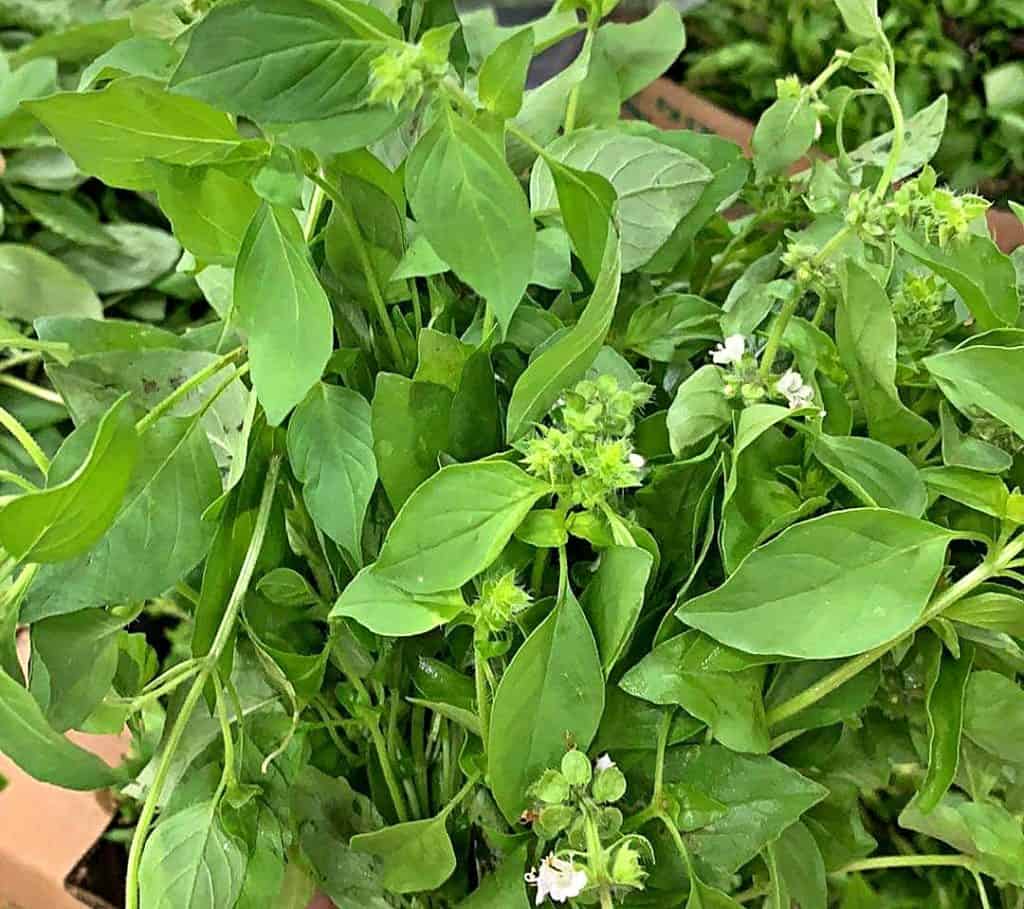
Bai Manglak, or Lemon Basil, is a lemony-flavored kind of basil with a light green stem and light green leaves. It tastes and smells similar to holy basil but the leaves are a little bit smaller. The leaves are used in certain Thai dishes like Kanom Jeen Nam Ya (curried coconut-fish sauce noodles). Lemon Basil is also extensively used in Issan (northeastern Thailand) cuisine as a garnish, accompanying herb, and vegetable in stews. Lemon Basil is not easy to find in most Asian stores, sweet basil and mint or holy basil can be used as a substitute.
Chilies
11. Bird’s Eye Chilies (Prik Kee Noo)
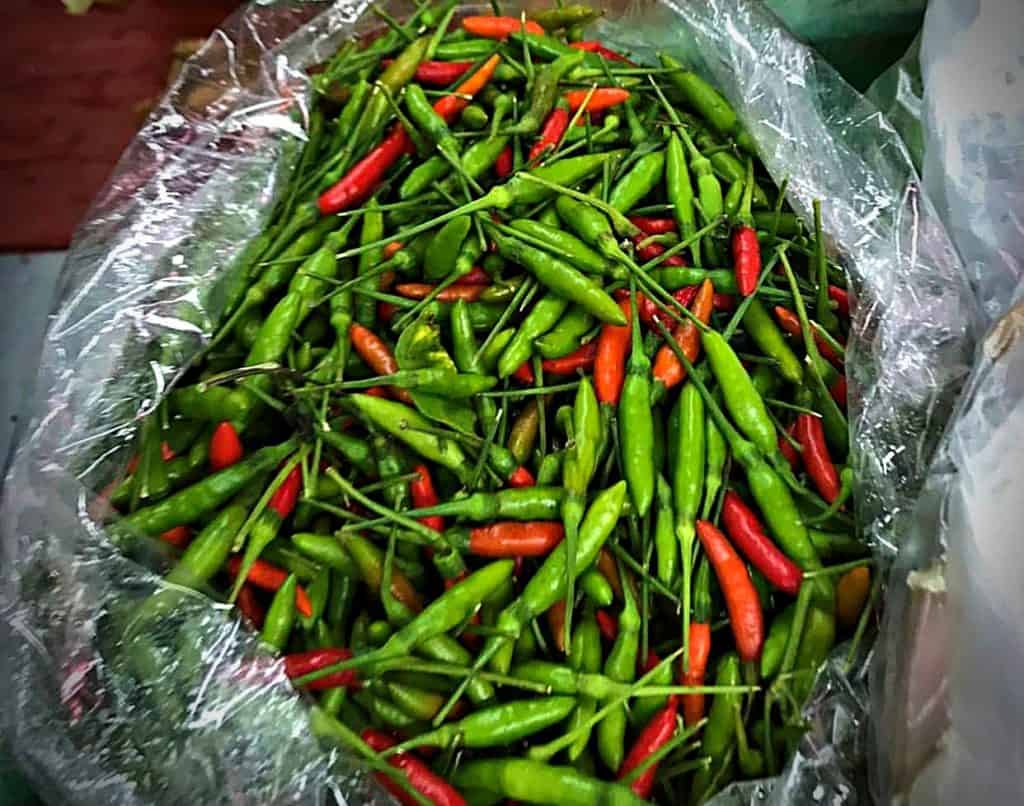
Bird’s eye chilies, also known as Thai chilies, are small-but-mighty chili peppers that are hotter than Jalapeno but a little bit less hot than Habanero Pepper. They are used in a lot of spicy Thai dishes like Som Tum (papaya salad), Pad Kra Pao (stir-fried holy basil with ground pork), and Tom Yum Soup. The Bird’s eye chili peppers are also used in many chili and curry pastes such as Green Curry and Red Curry. Thai people sometimes eat them raw with Isaan Sausages and spring rolls.
12. Cayenne Pepper (Prik Chi Faa)
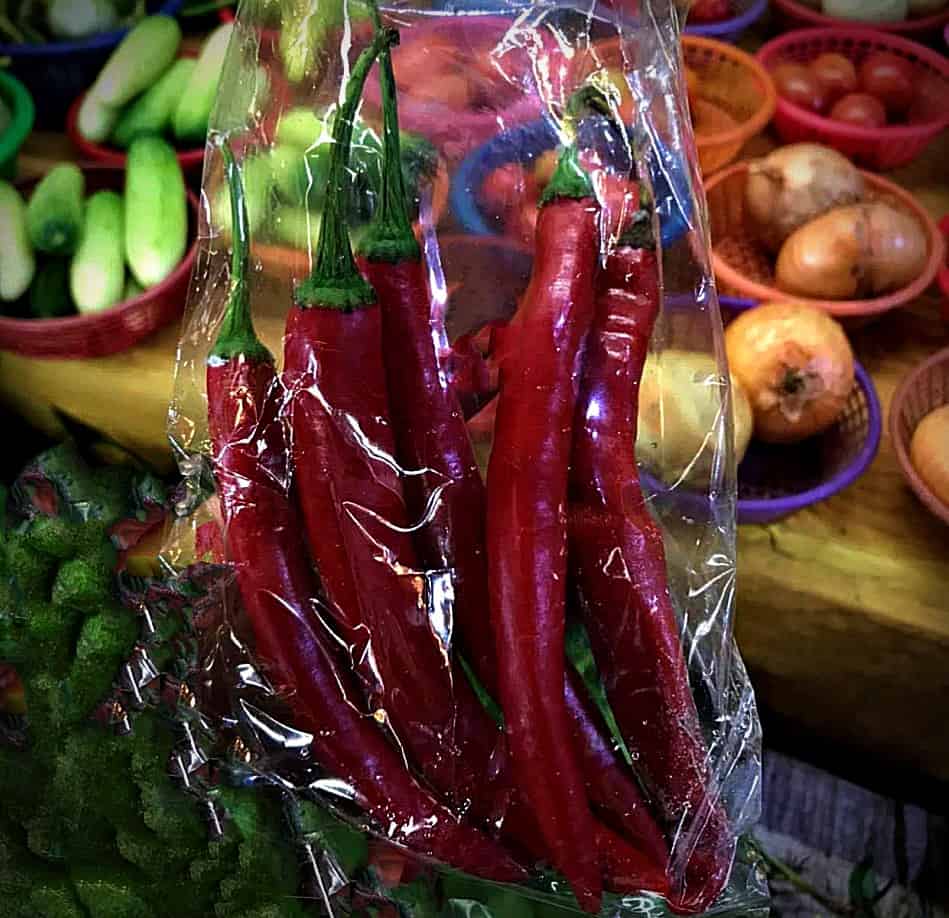
Cayenne Pepper is one of the many kinds of chili peppers you will find in Thailand. These are large six-inch-long red or green peppers with a fat, thick wall and smooth skin. Compared to bird’s eye chilies, Cayenne Pepper is much milder when picked early and used in milder dishes. One way to cook Cayenne Pepper is grinding them into a paste to be used in a stir-fry, chili dip, and soup broth base. Fun fact: Cayenne Pepper created the blueprint for the Sriracha hot sauce before it got converted to the Vietnamese-American version. Another fun fact: The pepper’s name translates to “sky-pointing pepper” in Thai because the pepper’s bottom literally points to the sky when fully grown!
13. Dried Chili (Prik Haeng)
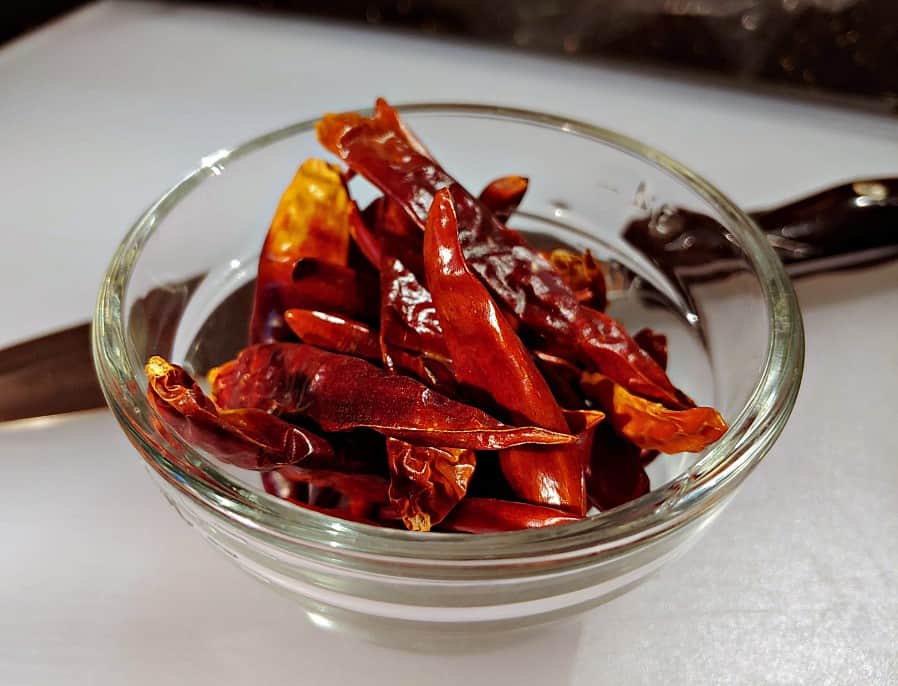
Thai people eat chilies in all forms; dried, fried, pickled, and fresh. Prik Chi Faa is the most common type of Thai chilies to sun-dry as its red color is intensified and preserved, and that gives many dishes a bright red color. Dried chilies can be pounded in a mortar and pestle to be used as a condiment for Thai noodle soups. Whole dried chilies are also used in broths, coconut soups, and curries as they add beautiful color to the dish.
Fruit Used Like Spices
14. Tamarind (Ma Kaam)
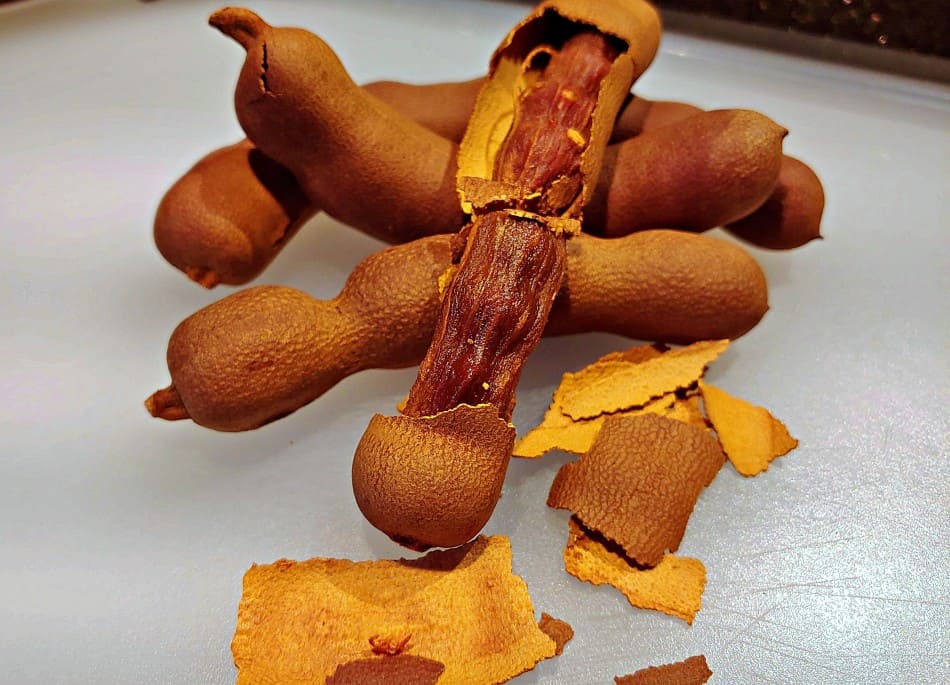
Tamarind is a date-like textured fruit in a bean-like pod with seeds in the middle surrounded by a fibrous pulp. The taste ranges from sweet, sour, tangy, and tart depending on ripeness. While the ripe fruit is enjoyed all year long among Thais, Tamarind juice is an essential ingredient in Thai cuisine. The juice adds a sharp, sour flavor without the tartness of lime. Sometimes the tamarind juice and lime juice are used interchangeably in cooking. Tamarind juice also makes a deliciously refreshing drink to beat the summer heat.
15. Lime (Ma Now)
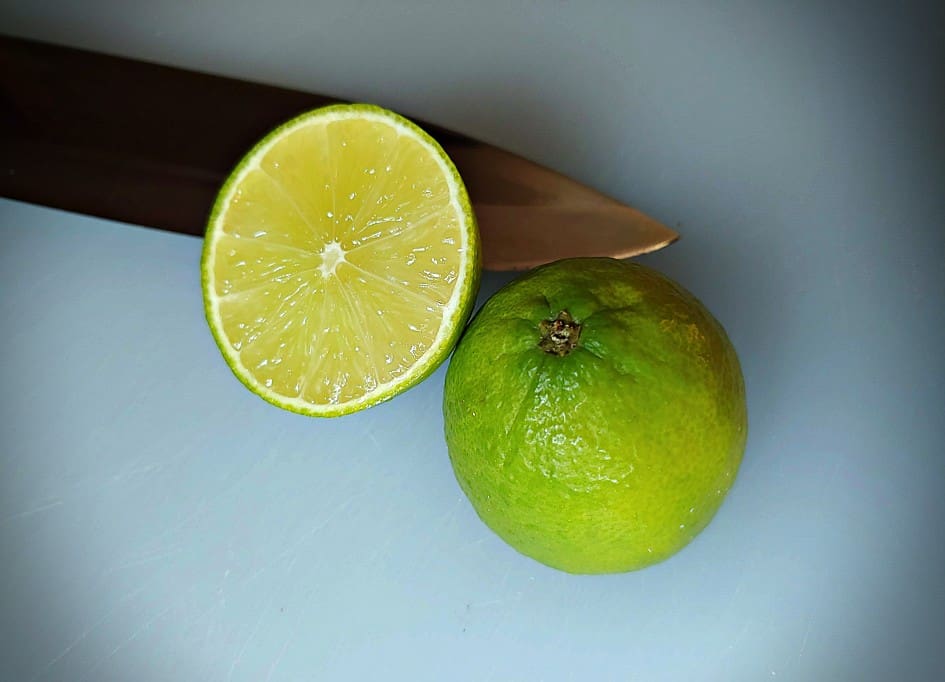
Limes, not lemons, are one of the bedrocks of Thai cooking. They give a robust zesty sour flavor to many Thai dishes that Thai people love. Lime juice is almost always required in any recipe that calls for fish sauce. One of Thai household’s must-have condiments, Nam Pla Prik, is basically just lime juice, sliced bird’s eye chili, and fish sauce. If limes are not available, lemons may be a substitute, but that may lack the vigor that limes give.
16. Kaffir Lime (Makrut)
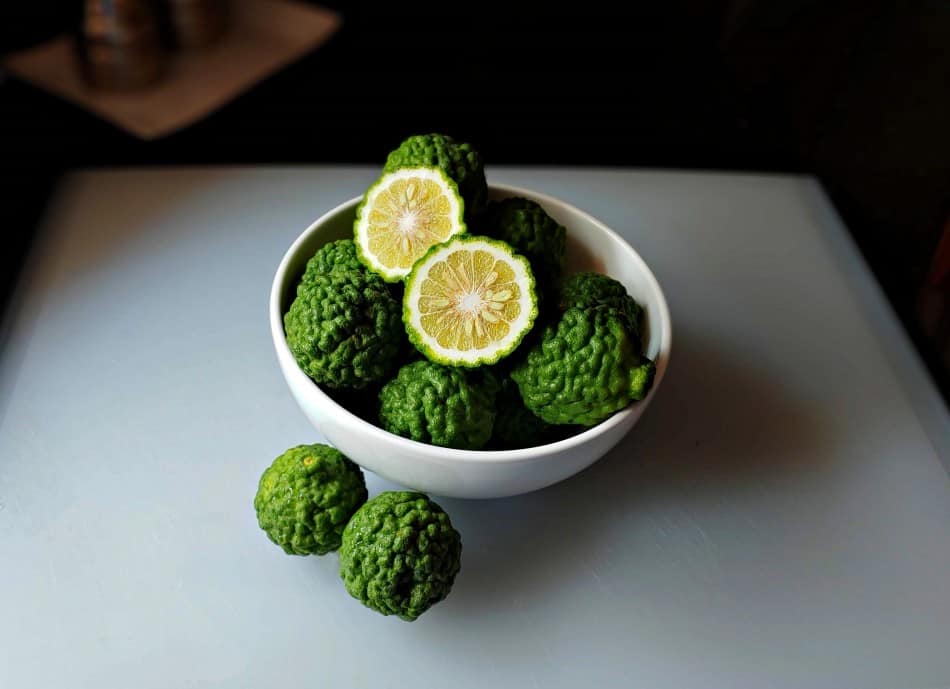
Besides the regular limes, Kaffir Limes are commonly used in Thai cuisine. The skin, juice, and leaves if these green limes can all be used. The skin of Kaffir Lime may look rough and bumpy, but the peel is widely used to make curry pastes by pounding it in a mortar and pestle together with other ingredients. Kaffir limes are extensively found in Thai aromatherapy, and especially shampoo among Thai locals. Its acidity helps remove oil build-up.
Leaf Family
17. Kaffir Lime Leaves (Bai Makrut)
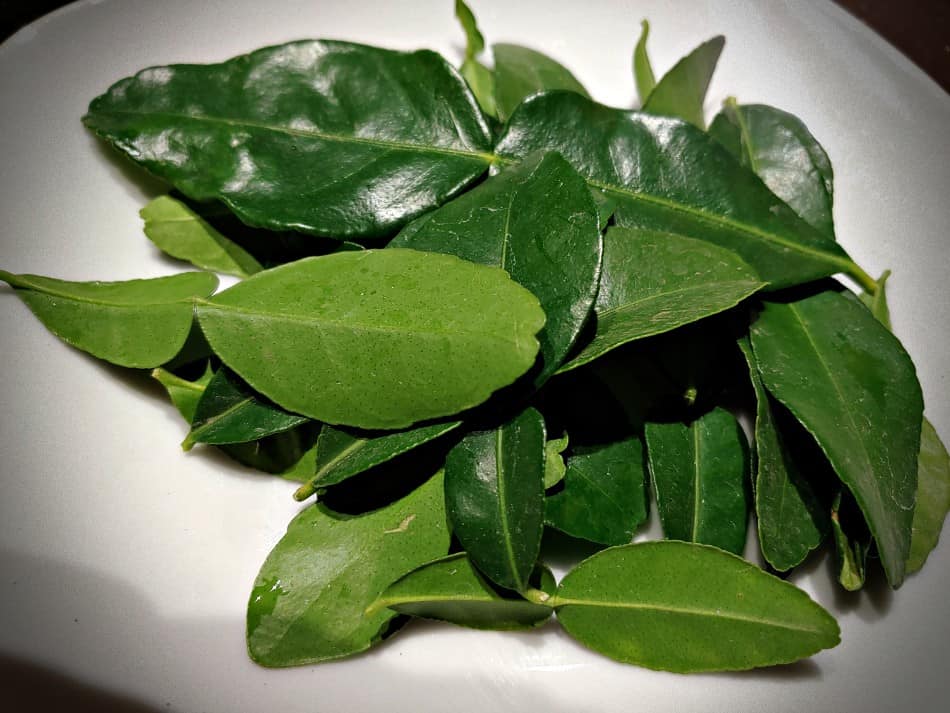
Kaffir Lime leaves are what is mainly harvested from the Kaffir Lime tree. They are abundant with very aromatic scents that make soups, salads, curries, and stir-fried dishes smell delicious and very “Thai.” The leaves have an hourglass shape, which looks like two leaves at the end of each stem. Remove the ribs before cutting the leaves or add whole to dishes so they let out more aroma. Kaffir Lime leaves are very hard to find and hard to grow. If you find some make sure you freeze them for later use! They will retain all the flavor when thawing
18. Bay Leaf (Bai Krawan)
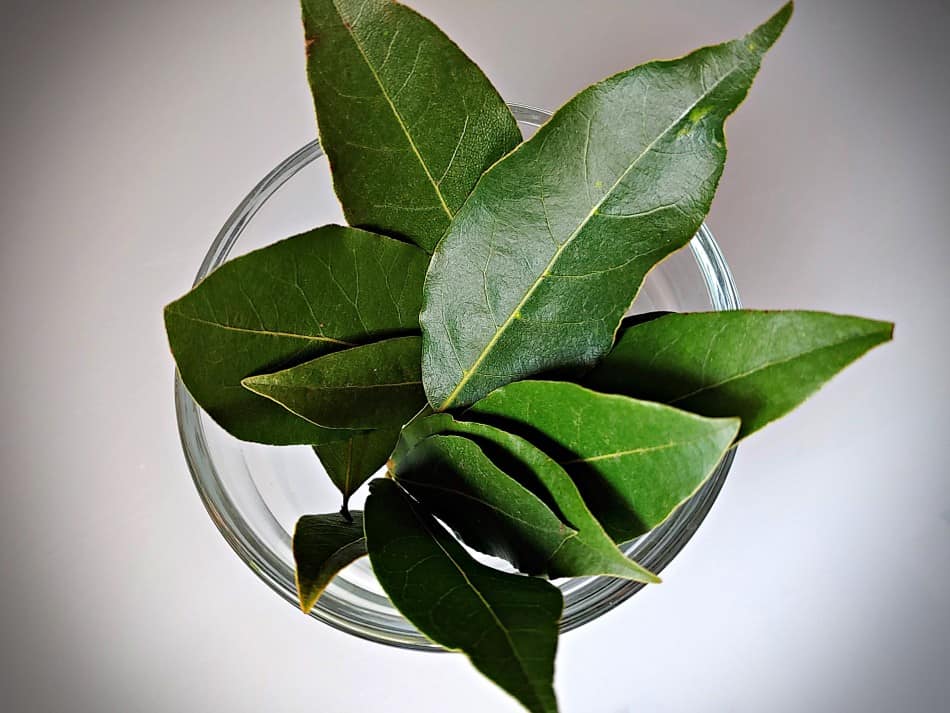
One of the less commonly used spices in Thailand, Bay Leaves are only used, and a quite important ingredient, in Malay-influenced dishes like Massaman Curry. Dried Bay Leaves have an herbal, floral fragrance similar to thyme and oregano. The leaves are usually cooked whole in Thai cuisine and removed before serving. Bay Leaves can also be a great substitute for Kaffir Lime leaves which could be hard to find in regular food stores.
19. Spearmint (Saranae)
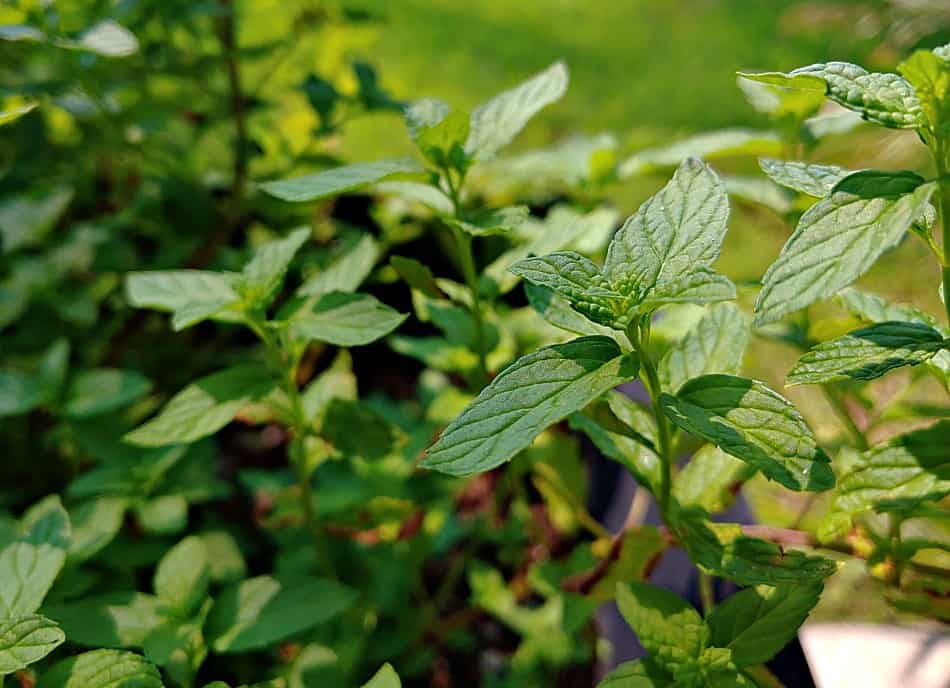
Spearmint is used in Northeast Thailand’s famous Laab (spicy ground meat salad) and other salads like Pla Koong (spicy shrimp salad). The mint leaves are also served with noodle soups. It is best used fresh, exploding an exhilarating taste when combined with bird’s eye chilies and lime juice. Also, Spearmint is good for relieving symptoms of digestive problems including gas, indigestion, nausea, and diarrhea.
20. Cilantro (Pak Chee)
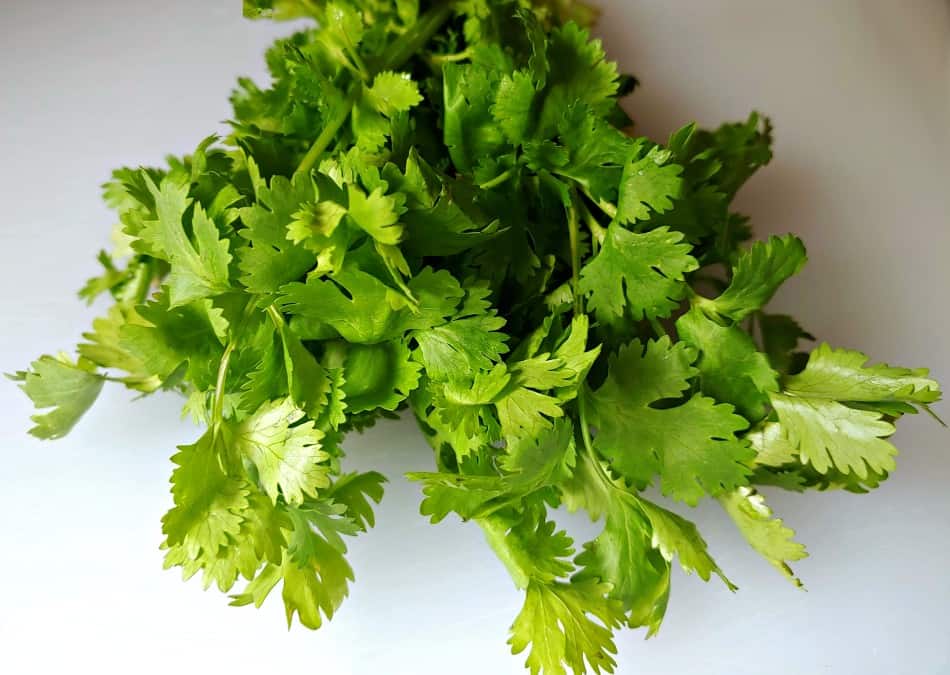
Cilantro leaves are used for garnishing for any typical Thai dishes. They have a strong earthy taste and smell which can be a hit or miss for many people.
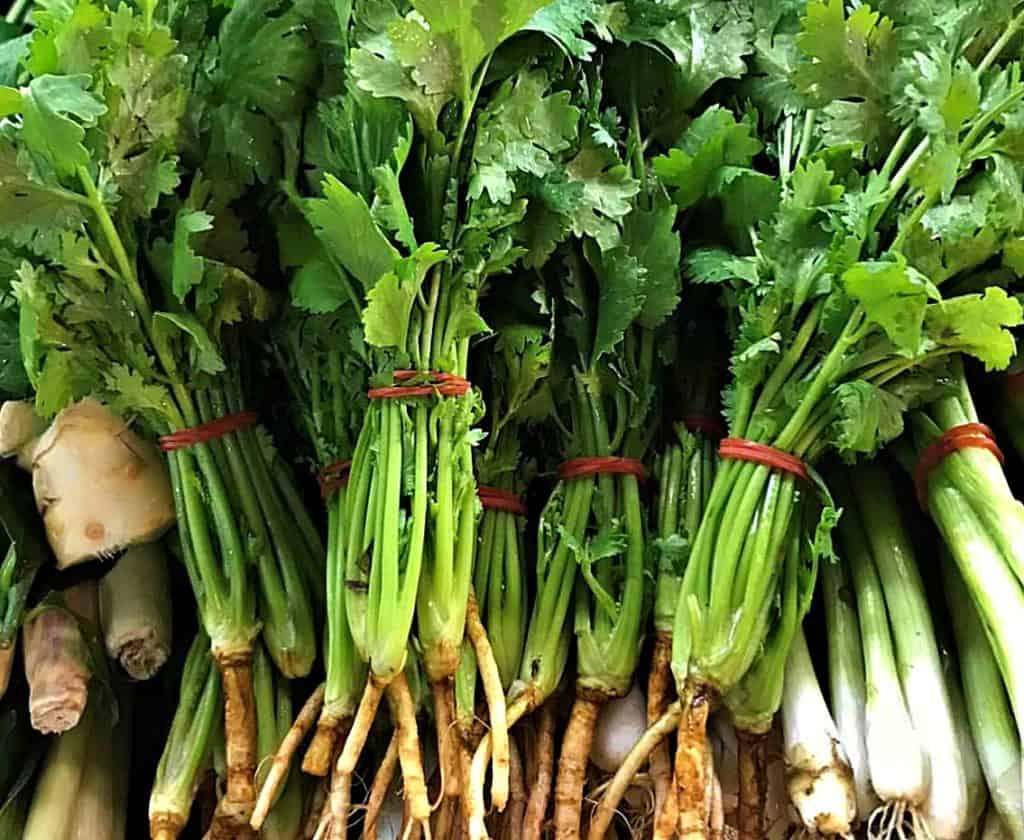
In addition, Cilantro roots have a more intense flavor and they are essential for Thai seasoning and marinating. Anything from grilled, deep-fried, to soups, they all call for cilantro roots. You can say you hate cilantro but you will be surprised how many Thai dishes you have had that contain cilantro roots, it’s just that other strong flavors in Thai food balance it out.
21. Culantro (Pak Chee Farang)
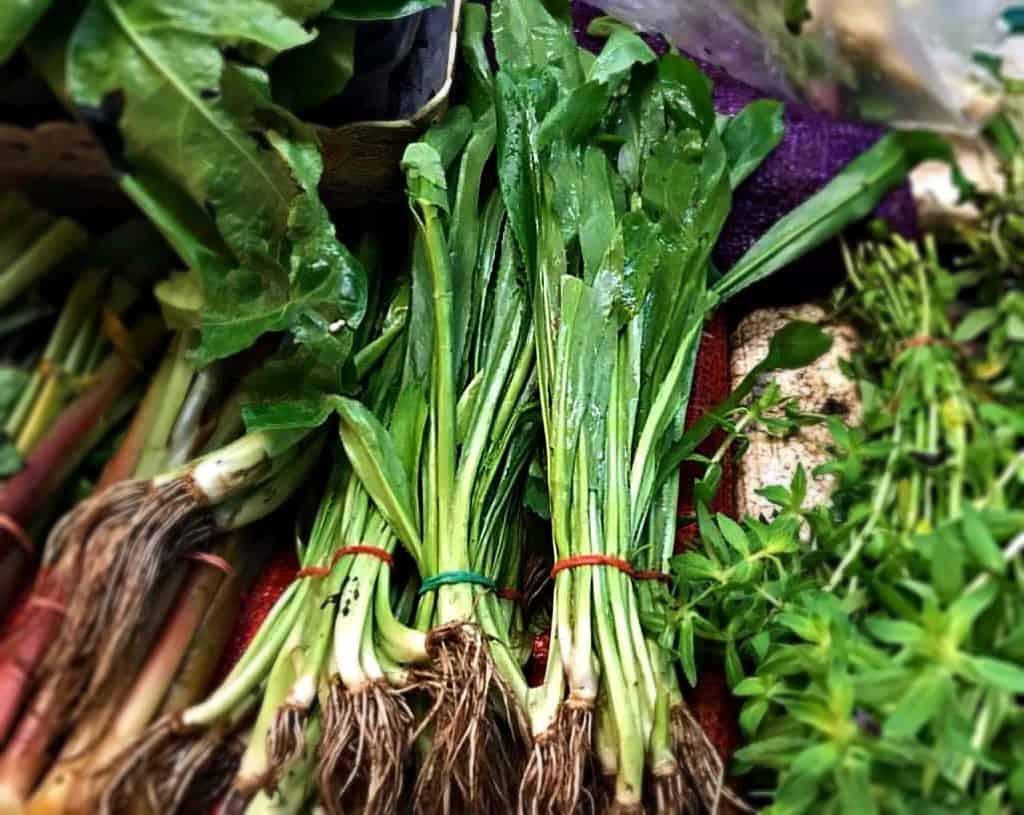
Not to be confused with Cilantro, Culantro is a commonly used vegetable in Isaan cuisine (northeastern Thailand). It has saw toothed leaves and looks a bit like Romaine lettuce. The leaves smell earthy, similar to Cilantro, but a bit stronger. Culantro is often cut into skinny strips and sprinkled on spicy soups, especially Tom Yum Pla (hot and sour fish soup). It is normally eaten raw and served with other herbs and vegetables as a condiment for spicy dishes.
22. Leaf Celery (Keun Chai)
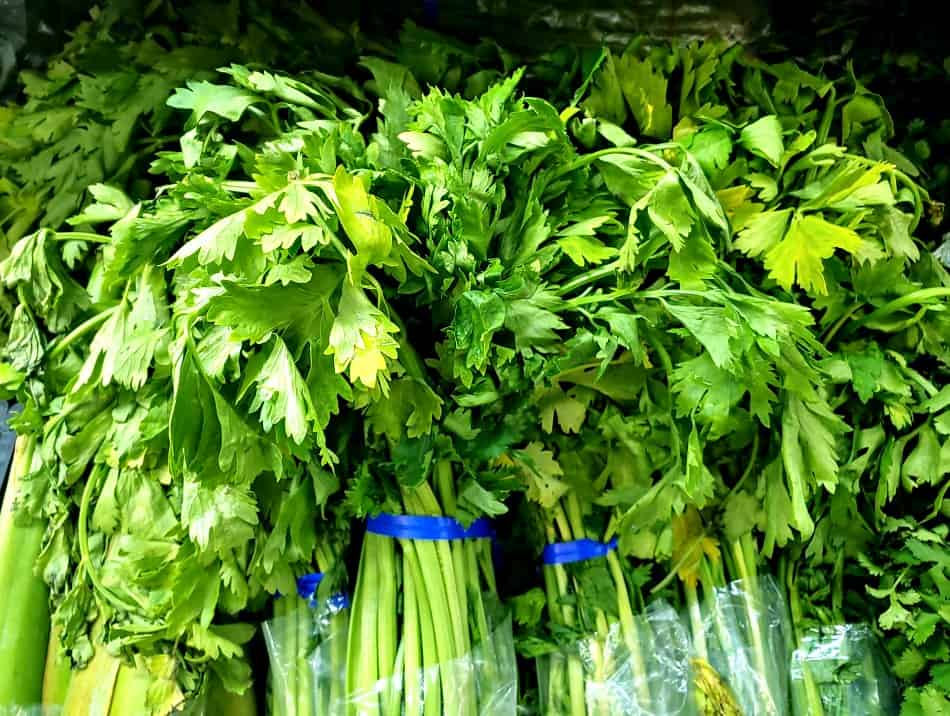
Leaf Celery (aka. Chinese Celery) is skinny, leafy celery that is grown for its leaves. In Thai cuisine, the leaves are used in making salads like Yum Talay (spicy seafood salad) and garnishing Thai rice porridge as the green big leaves are attractive and they enhance the flavor at the same time. The difference between Leaf Celery and the regular celery, Stalk Celery, that you find in American grocery stores is that the Leaf Celery’s stalk is not as big, less crunchy, but has a much stronger flavor.
23. Pandan Leaf (Bai Toey)
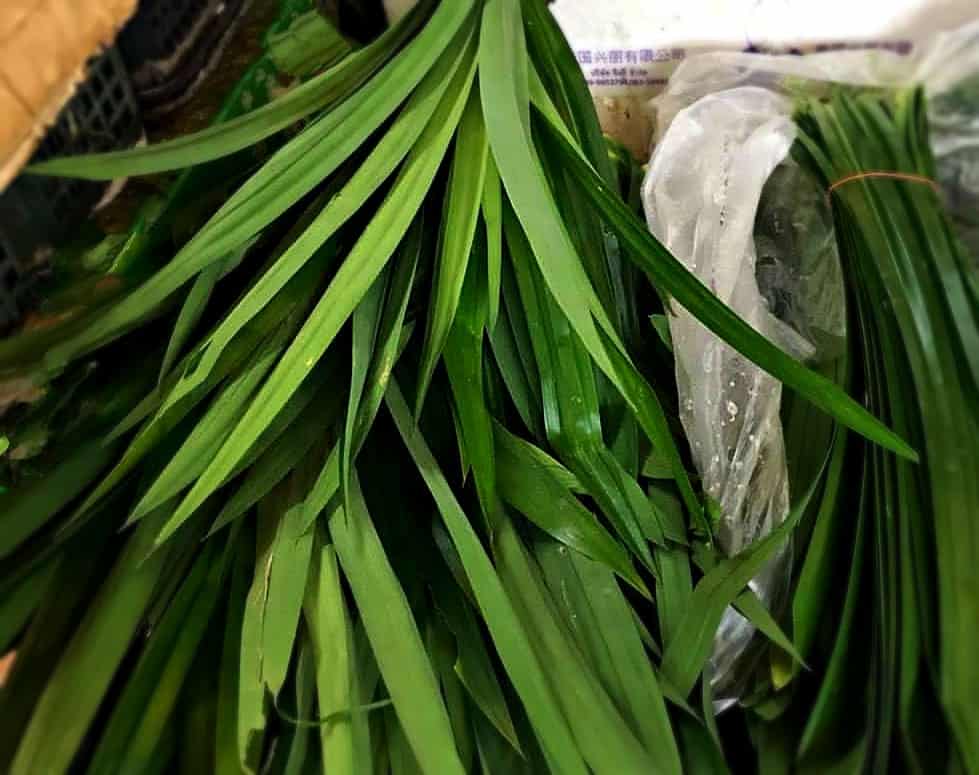
Known as the vanilla of Thailand, Pandan is a long narrow green leaf that is used for flavoring, coloring, steam wrapping, and fragrant scents. Its juice is released when pounded giving a heavenly sweet fragrance similar to roasted young coconut to desserts that are unique to Thailand, plus it gives a bright green color to the desserts. Pandan leaves are also used as a food wrap which adds fragrance to the meat during grilling and steaming.
What’s more, Pandan leaves can be folded and put inside a car as an air freshener, something you commonly see in Thai taxis.
24. Cha-Om
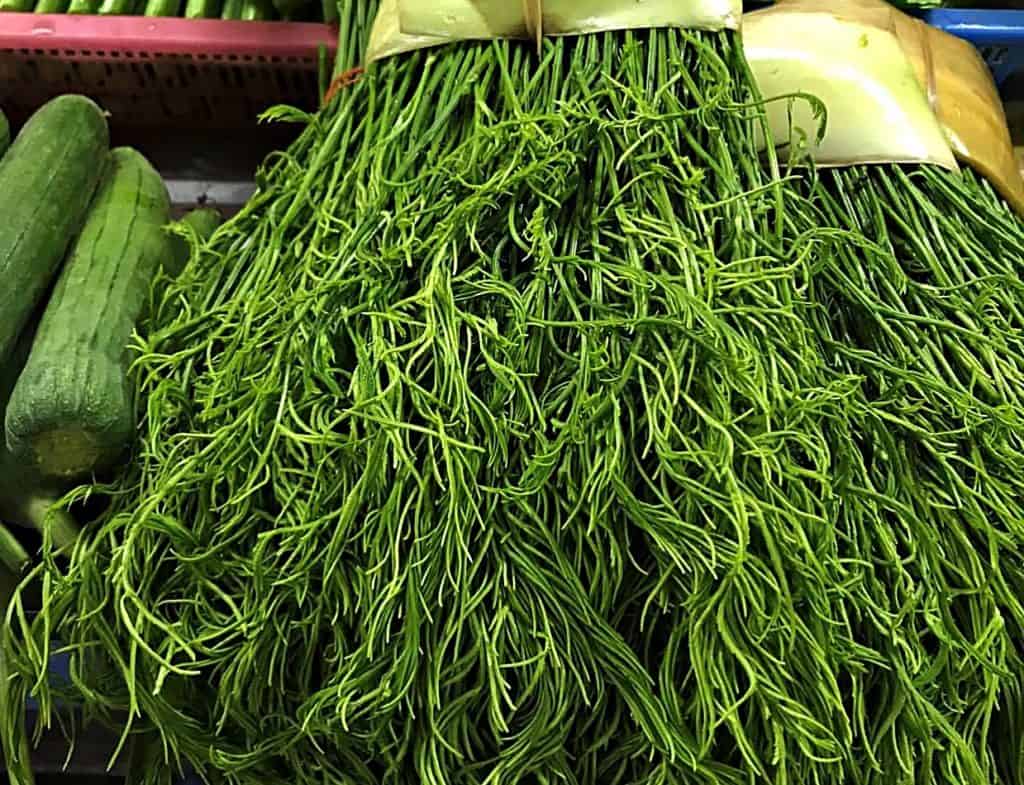
Cha-Om is a shrub-like plant that looks similar to a fern. The aroma of fresh Cha-Om is almost sulfur-like which is not necessarily pleasant, but it mellows when cooked. Thai people like to add it in the egg dish, Kai Jiew Cha-Om (Thai-style omelet). The leaves can also be cut and served with a more pungent chili dip Nam Prik Ka Pi (shrimp paste chili dip).
25. Lemongrass (Ta Krai)
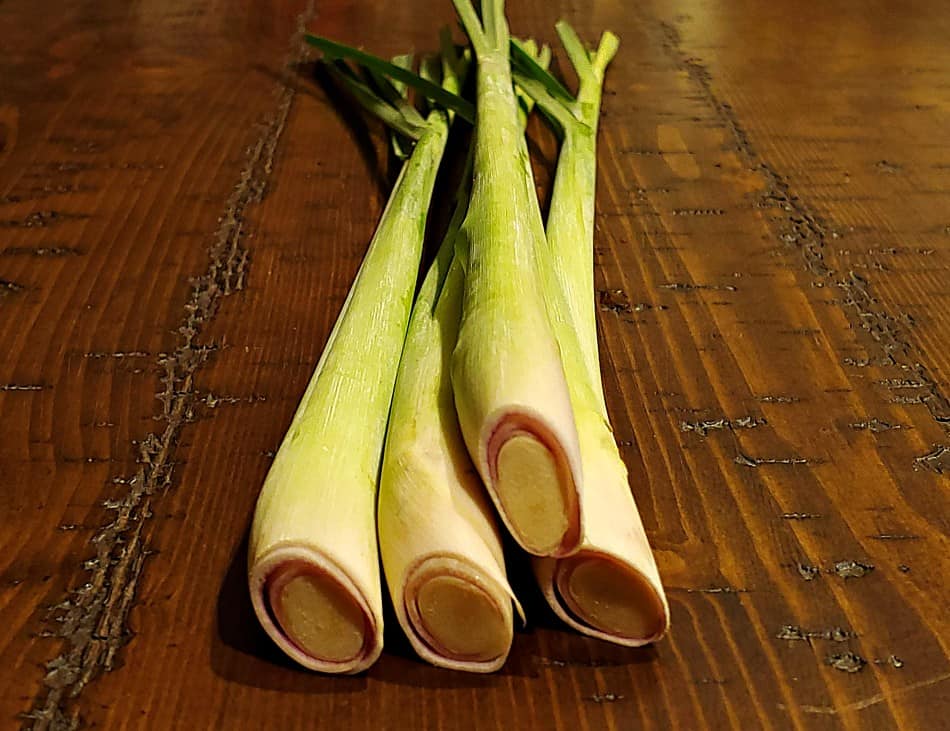
Lemongrass is a tall plant that resembles a grass with a small bulbous root. Its lemony smell from the bulb and base leaves are often used to enhance the aromatic scent in soups like Tom Yum Soup and Tom Gai Khamin (chicken soup with lemongrass and turmeric). The pounded white interior is used as the main ingredient of Thai curry pastes. Lemongrass is also good sliced for use in salads and fried to be topped on fried chicken as well.
Pepper
26. Green Peppercorns (Prik Thai Sod)
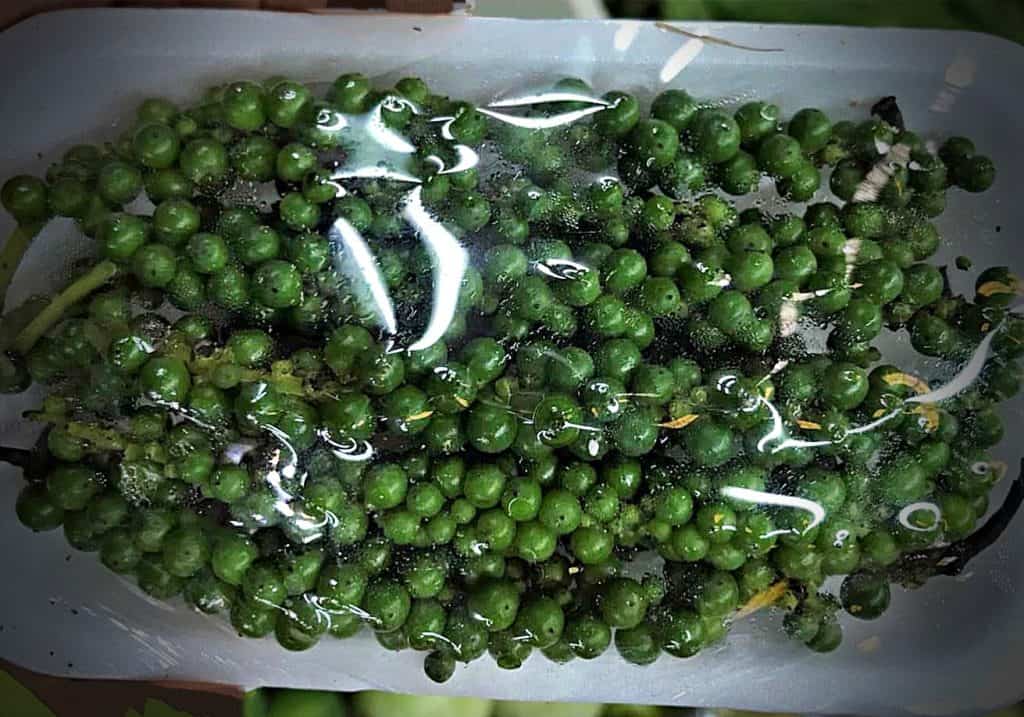
These young green peppercorns are soft, pungent, and mildly hot. They are used in curries, stir-fry, and Nam Prik (chili dips) in Thailand. The whole bunch of fresh peppercorns is commonly tossed into Pad Khee Maw (Drunken Noodles) or Green Curry. In addition to the Green Peppercorns’ distinct heat, its instant benefit is to aid digestion and promote appetite.
27. White Pepper (Prik Thai)
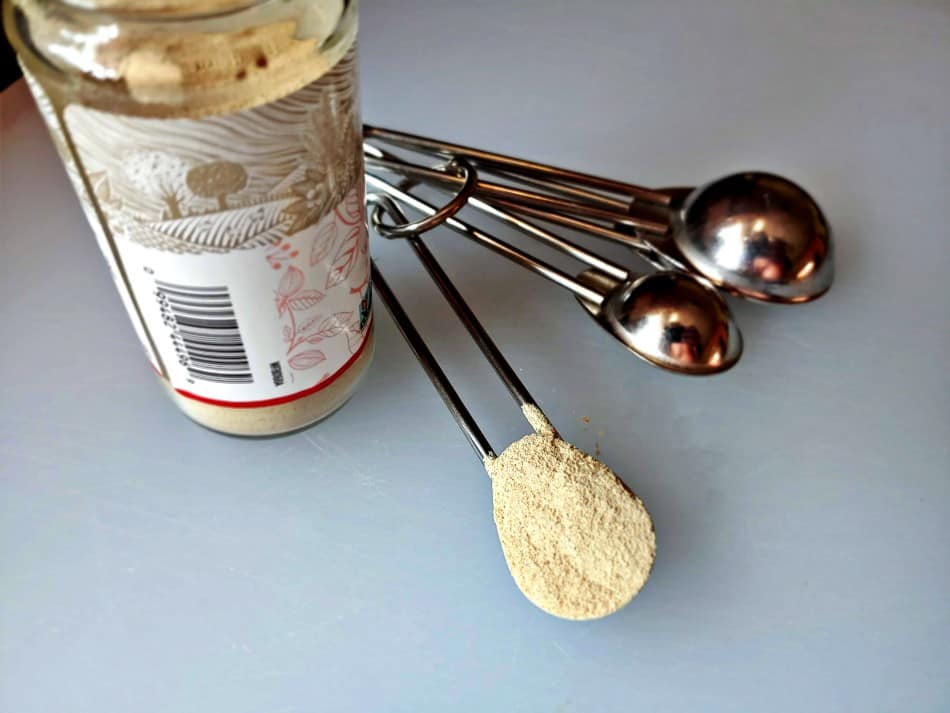
Ground White Pepper is one of the key ingredients of Thai cuisine. It is often dusted on top of a dish as a final step to enhance the fresh smell and heat. Whereas western dishes are better with fresh ground black pepper, Thai dishes are better with pre-ground white pepper, and it is something you find on the table at any restaurant in Thailand. The White Pepper is more gentle and does not overwhelm the food. Mixed together with cilantro seeds and garlic and it becomes a natural Thai flavor enhancer!
28. Black Pepper (Prik Thai Dam)
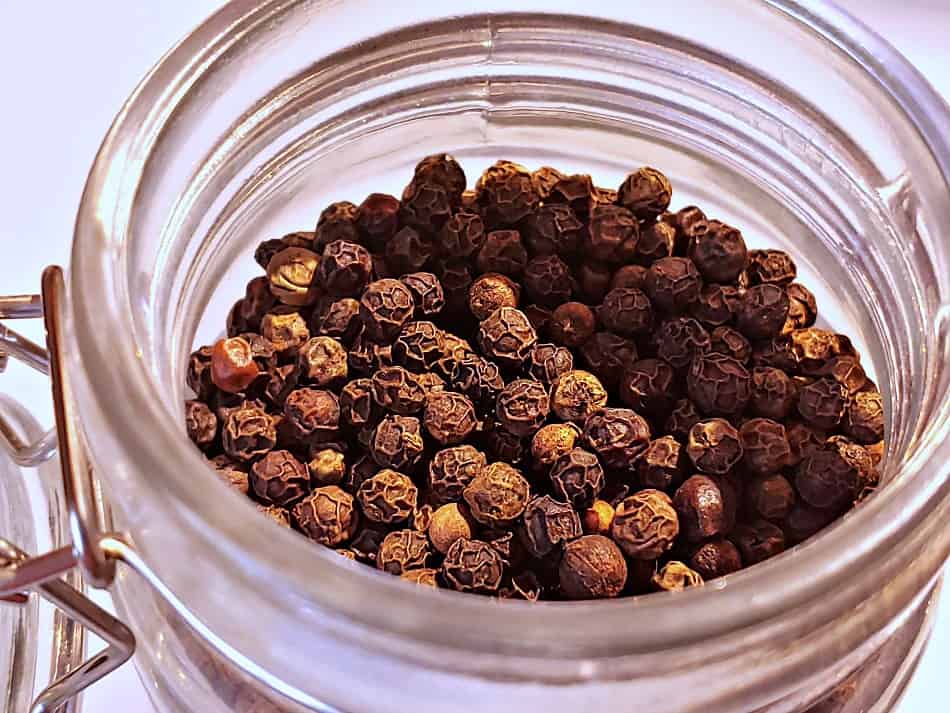
Beside white pepper, Black Pepper is also used in certain Thai stir-fried and grilled dishes. The strong flavor of Black Pepper can deodorize seafood and beef smells which can sometimes overpower the smell of other ingredients. Moo Pad Prik Thai Dam (black pepper pork stir-fry) and Gai Yang Prik Thai Dam (grilled pepper chicken) are the most prominent Thai dishes that use Black Pepper.
Spices
29. Cumin (Yee Rah)
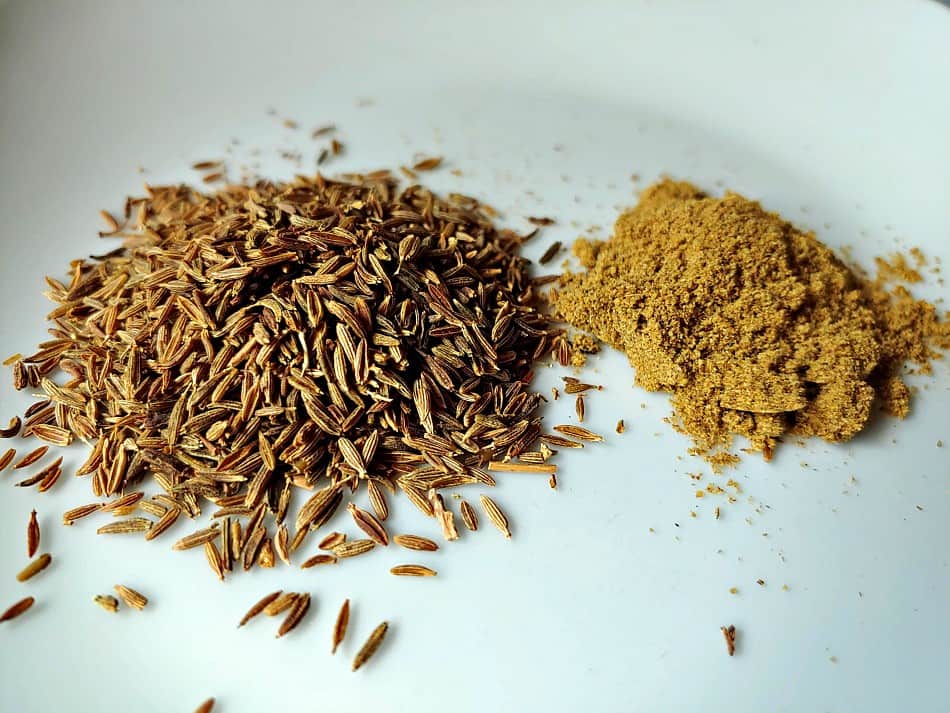
Cumin is a commonly used Thai spice to add an earthy feeling to curry pastes like Panang and Green Curry. The seeds are roasted and pounded to release the aroma. Cumin seeds can easily overpower the food, hence you should be careful not overuse them. That is why some Thai people use Cumin in beef dishes to deodorize the beefy smell, which is not familiar to Thai people.
30. Cinnamon (Ob-Choey)
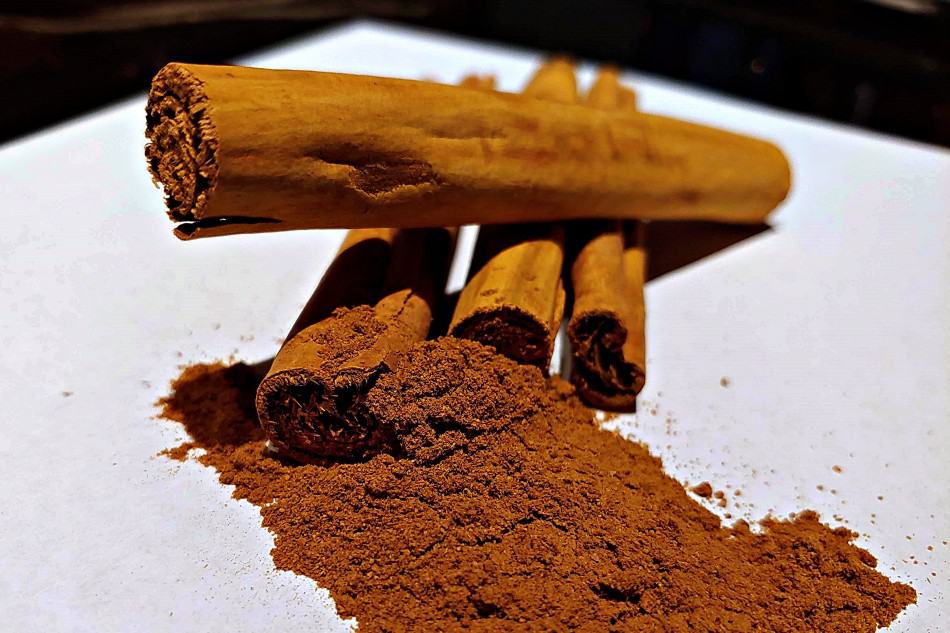
Cinnamon is one of the most popular spices in the world, but Thai people don’t use cinnamon the way most Western countries do. Westerners use cinnamon to add aroma and sweet flavor to desserts, while Thai people use cinnamon to sweeten entrees to satisfy their love of sweet food. Cinnamon in Thai cuisine is converted from the dark brown bark into powder which is commonly used in Pa-Loe (five-spice pork stew), Massaman Curry, and noodle soup base.
31. Nutmeg (Chan Tet)
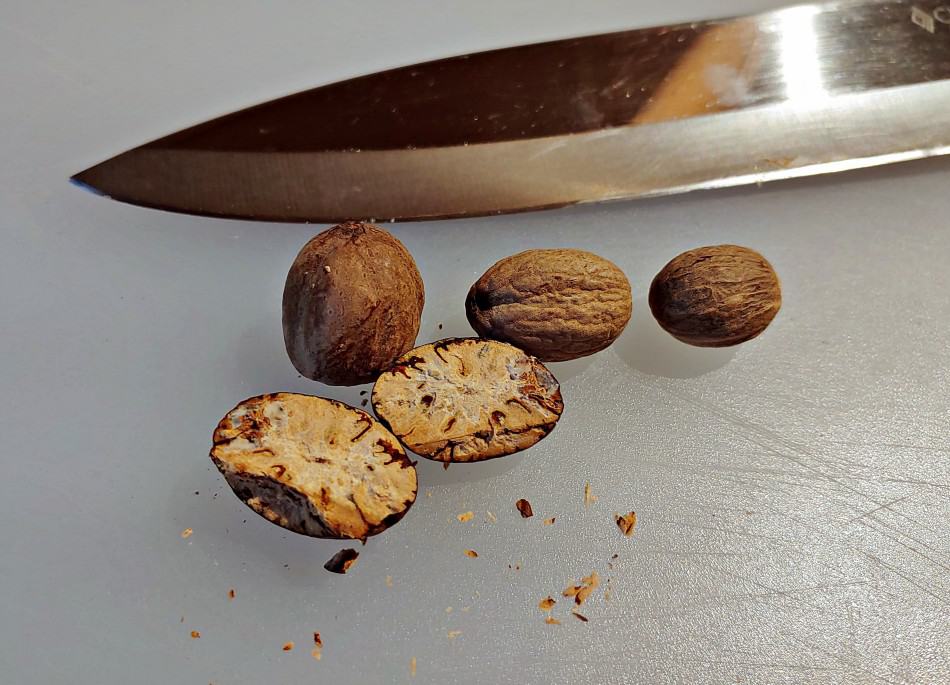
Nutmeg is a hard seed inside a yellow fruit. In Thai cuisine, Nutmeg is only used as an ingredient in Malay-influenced dishes like Massaman Curry. The seeds are more commonly used as medicine. Thai people grind the seeds into powder and cook in hot water to make a drink which helps soothe indigestion, relieve pain, detoxify, and reduce insomnia.
32. Clove (Kan Plu)
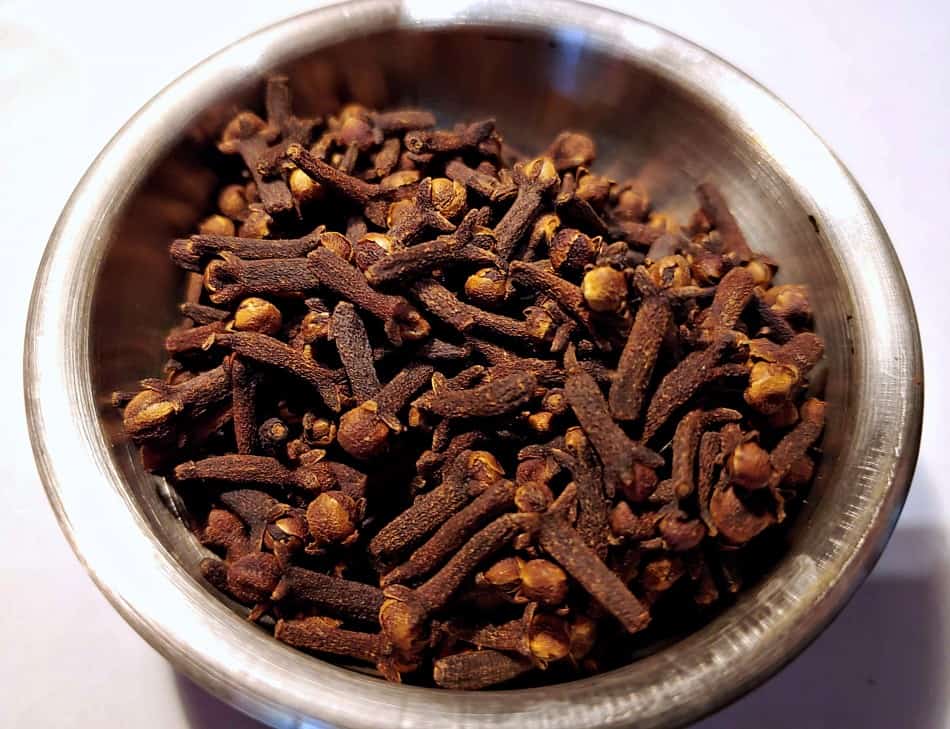
Another common spice in Thai cuisine, cloves are dark brown, aromatic dried flower buds of the clove tree. Cloves in the U.S. can be found both in whole and ground forms, but in Thailand the whole cloves are normally used. They add distinct, sharp, warm, and sweet tastes to sweet and savory dishes. Cloves are most commonly used in making noodle soup broth as well as other beef stews since its fruity nuance removes beef odor, which can be unpleasant to some Thais.
33. Cardamom (Luk Krawan)
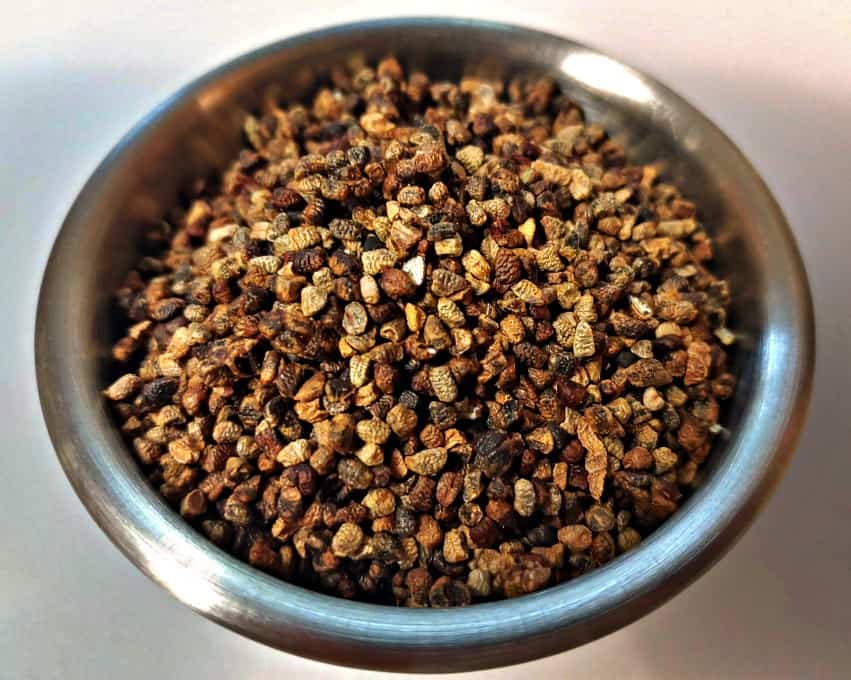
Cardamom is a spice from seed pods with a complex flavor of mint, camphor, and lemon. Green and brown Cardamom can be found in most Asian food stores. In Thailand, the brown pea-sized pods are used more than the green, and they have a more floral and less camphor flavor. Besides its use in Thai recipes, Cardamom is commonly used in Thai traditional medicine as it treats digestion problems and boosts metabolism.
34. Star Anise (Poy Kuk)
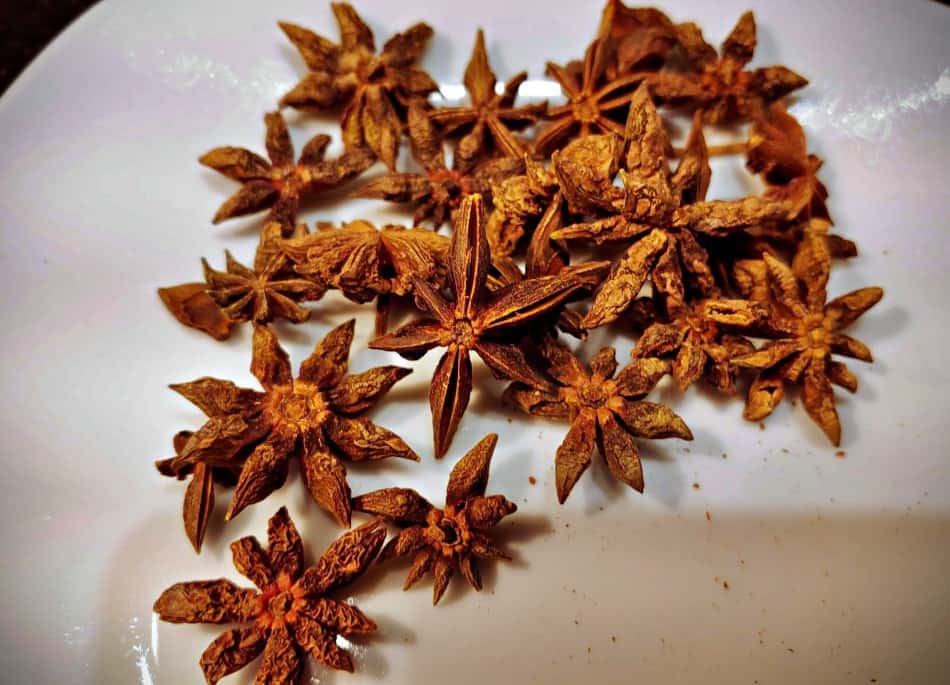
Star Anise, or Chinese Star Anise, is a spice indigenous to China that is a feature of numerous Asian cuisines. It is part of the Chinese five-spice blends. The strong sweet licorice aroma of Star Anise adds a unique taste in Khao Kha Moo (stewed pork hocks over rice), Kai Palo (five-spice egg & pork belly stew), and most Thai noodles soup base. Star Anise pods are very easy to spot; they resemble an eight-point star with a dark reddish-brown color. They should not be confused with Anise seeds, which are smaller and similar to fennel seeds. While they look pretty in the dish and give out the amazing aroma, they should not be eaten whole.
35. Coriander Seed (Luk Pak Chee)
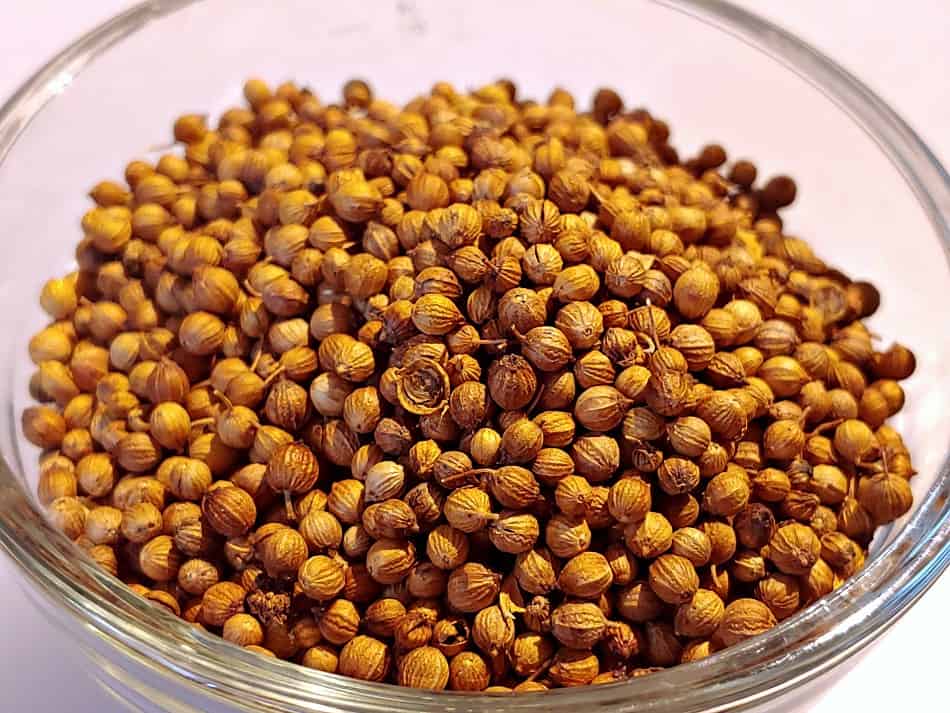
Thai Coriander Seeds are smaller, sweeter, and more fragrant than the Western varieties. They are one of the key ingredients in the Chinese five-spice which Thai people use for marinating and rubbing. Coriander Seeds are used whole to marinade beef and pork jerky as they retain the aromatic oils better. The ground form is mixed with cumin and turmeric to add a warm, nutty flavor to curry pastes like Massaman Curry, Green Curry, and Panang Curry.
Conclusion
Most of the herbs, spices, and vegetables above are readily available in Asian food stores in fresh, dried, and frozen forms. In case you are interested in growing some of these herbs and vegetables to use for your own cooking, there are some seeds available for purchase online. Chia Tai is a popular seed producer in Thailand that has seeds listed on Amazon (here is where I got my Holy Basil seeds). Be mindful that most of these plants grow well in tropical climates, and they may not grow as well in locations outside of Thailand.
Happy cooking from Thailand!


